Dollars for dancing are still available. Don’t wait any longer. Dreaming of dancing this summer but worried about the costs? Our Festival can still offer you financial help. Contact us livelyfoundation@sbcglobal.net and let us know you want to study, create, perform. The artist/teachers are eager to help you dance your best dances. The Festival opens on August 11; email us now. 
Author Archives: Leslie
Los Altos Town Crier Features IDF@SV
That terrific newspaper, The Los Altos Town Crier, featured the International Dance Festival@Silicon Valley in its most recent issue. LATC recognizes our Festival as a wonderful addition to the life of its community. The feature was in “Mountain View on the Move.” The Festival certainly does get Mountain View MOVING! Here’s the link to the article:
www.losaltosonline.com/…/mountain–view…/47987-lively-foundation-hosts- dance–festival
Tune up your technique! Try something you’ve never done before! Have a wonderful time! Come dance with us. FULL DAY OF DANCE© August 16; FESTIVAL CONCERT August 17. Do it!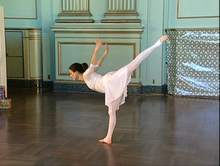
FULL DAY OF DANCE© CLASS SCHEDULE NOW
FULL DAY OF DANCE© is the unique, amazing innovation of International Dance Festival@Silicon Valley. The greatest dance experiences for everyone from pros to beginners. Take something you already know and love AND try something completely new to you! Never danced before? This is your time. A professional ballerina who stays up late watching Fred Astaire & Ginger Rogers tap? This is your chance to give it a try. Supportive, enthusiastic teachers. You’ll be in a class with all different levels. Someone might be a complete beginner at classical Indian dance but terrific in tap. Or — a total complete beginner–you name it; it’s all possible. You can take one, some, or all six classes. The price per class reduces with each added class. No special outfits or shoes required. Even for tap, wear a shoe that will stay on your feet; you can learn the rhythms & steps without taps on your soles, but your true soul will be dancing!!! Here’s the class schedule. Doors open at 8:30 a.m. Save time & pay in advance. Information: call 650/969-4110 or see us at facebook/international dance festival silicon valley and at facebook/The Lively Foundation.
9:00-10:00 Pilates mat (bring a towel or mat if you can); 10:15-11:30 Dunham technique; 11:45-1 p.m. tap; 1-1:30 Lunch Break; 1:30-2:30 Line Dancing with Etta; 2:45-4:00 Salsa; 4:15-5:30 Manipuri, an Indian classical dance. Prices: single class $25/all six $84–in between reduces per class with each added class.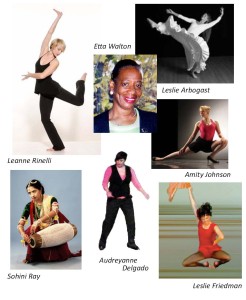
Scholarships Available to Dance at Festival!
 GET SOME DOUGH!!
GET SOME DOUGH!!  Financial aide is still available to help you attend the International Dance Festival@Silicon Valley. Funds are available NOW. Do not miss this great opportunity! Let us know of your desire to attend as soon as you can. In addition to scholarship aide, IDF@SV offers more ways to reduce your costs: FREE homestays in lovely homes only a few blocks away from the Festival center for all classes and events; bring another dancer to the Festival, and you both will get a discount; members of Dancers’ Group get a 10% discount on all classes and events.This is YOUR time to dance. It is YOUR time to perform in a real, public concert on a program with acclaimed professionals. It is YOUR chance to create a dance to be performed on the Festival Concert. Come dance with us!!
Financial aide is still available to help you attend the International Dance Festival@Silicon Valley. Funds are available NOW. Do not miss this great opportunity! Let us know of your desire to attend as soon as you can. In addition to scholarship aide, IDF@SV offers more ways to reduce your costs: FREE homestays in lovely homes only a few blocks away from the Festival center for all classes and events; bring another dancer to the Festival, and you both will get a discount; members of Dancers’ Group get a 10% discount on all classes and events.This is YOUR time to dance. It is YOUR time to perform in a real, public concert on a program with acclaimed professionals. It is YOUR chance to create a dance to be performed on the Festival Concert. Come dance with us!!
Impressionist France: Visions of Nation from Le Gray to Monet
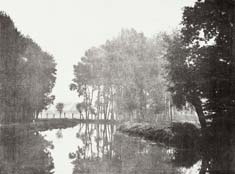
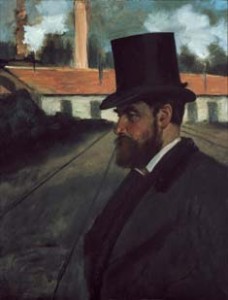 Excellent art news: the St. Louis Art Museum has extended its wonderful exhibition: Impressionist France: Visions of Nation from Le Gray to Monet through July 14. 2014. Bien sur! but of course, it must continue to Bastille Day! This special exhibition should not be missed by anyone interested in impressionist paintings, French culture and history, city planning, and especially photography. It is particularly apt to see the 120 paintings and photographs that came to St. Louis from around the US and Europe here in a city with ancient ties to France. In fact, St. Louis, founded by French settlers and fur traders, is now celebrating its 250th anniversary. The exhibition has an unusual approach, traveling through France in seven themes: Paris and the development of the city, monuments, rivers and forests, rural and agricultural life, mountains, seascapes, trains and factories. The works on display explore the era 1850-1880. Astonishing works of early photography, Impressionist paintings, and the high point of the Barbizon School of landscape painting are featured. The Barbizon artists include Corot and Rousseau; the Impressionists include Cezanne, Degas, Manet, Monet, Morisot, Pissaro. The fascinating idea uniting all aspects of the exhibition is the way in which images of the French landscape developed ideas of national identity. Viva La France and Bonne Anniversaire a St. Louis. Vite Vite (quickly!) find your way to this wonderful museum in Forest Park. Founded for the 1904 World’s Fair (that’s right, the one with Judy Garland) and recently enlarged and improved. Pictures: (L to Rt) Adalbert Cuvelier, printed by Alphonse-Louis Poitevin, Effect of Fog, 1852, photolithograph; Edgar Degas, Henri Rouart in Front of His Factory, c. 1875, oil on canvas. Courtesy St. Louis Art Museum.
Excellent art news: the St. Louis Art Museum has extended its wonderful exhibition: Impressionist France: Visions of Nation from Le Gray to Monet through July 14. 2014. Bien sur! but of course, it must continue to Bastille Day! This special exhibition should not be missed by anyone interested in impressionist paintings, French culture and history, city planning, and especially photography. It is particularly apt to see the 120 paintings and photographs that came to St. Louis from around the US and Europe here in a city with ancient ties to France. In fact, St. Louis, founded by French settlers and fur traders, is now celebrating its 250th anniversary. The exhibition has an unusual approach, traveling through France in seven themes: Paris and the development of the city, monuments, rivers and forests, rural and agricultural life, mountains, seascapes, trains and factories. The works on display explore the era 1850-1880. Astonishing works of early photography, Impressionist paintings, and the high point of the Barbizon School of landscape painting are featured. The Barbizon artists include Corot and Rousseau; the Impressionists include Cezanne, Degas, Manet, Monet, Morisot, Pissaro. The fascinating idea uniting all aspects of the exhibition is the way in which images of the French landscape developed ideas of national identity. Viva La France and Bonne Anniversaire a St. Louis. Vite Vite (quickly!) find your way to this wonderful museum in Forest Park. Founded for the 1904 World’s Fair (that’s right, the one with Judy Garland) and recently enlarged and improved. Pictures: (L to Rt) Adalbert Cuvelier, printed by Alphonse-Louis Poitevin, Effect of Fog, 1852, photolithograph; Edgar Degas, Henri Rouart in Front of His Factory, c. 1875, oil on canvas. Courtesy St. Louis Art Museum.
Summer’s Here! Time to Dance!
 Summer is here! There’s the Solstice Sun rising at Stonehenge; it must be summer and time to dance. Come to the International Dance Festival@Silicon Valley, stretch your technique, find your center, explore your inner rhythms, let it all out: DANCE! The artists are waiting to teach you their choreography and hone your technique. They want to bring out your best in an atmosphere that encourages you to shine. Now’s the time. Don’t wait. Scroll down for post with registration links. Send your registration and then send your whole self for a glorious week of dance. It’s crowned with the Festival Performance, a real performance for a real public, and a program featuring the guest artist/teachers/choreographers and YOU!!! Everyone is eager to meet you and watch you fly.
Summer is here! There’s the Solstice Sun rising at Stonehenge; it must be summer and time to dance. Come to the International Dance Festival@Silicon Valley, stretch your technique, find your center, explore your inner rhythms, let it all out: DANCE! The artists are waiting to teach you their choreography and hone your technique. They want to bring out your best in an atmosphere that encourages you to shine. Now’s the time. Don’t wait. Scroll down for post with registration links. Send your registration and then send your whole self for a glorious week of dance. It’s crowned with the Festival Performance, a real performance for a real public, and a program featuring the guest artist/teachers/choreographers and YOU!!! Everyone is eager to meet you and watch you fly.
Gold Rush in Fremont!
Bringing The Gold Rush! to the Brookvale School, Fremont, CA, was a fantastic way to close this spring season. Wonderful students and teachers filled the auditorium. The Lively Foundation performers truly hit it out of the park; a great performance by dancers Amity Johnson & Audreyanne Delgado Covarrubias, singer & banjo player Jonathan Clark. Ms Johnson & Ms Covarrubias also narrate comments originally written by people living in the mining fields. Mr. Clark is the tech director setting up and running the sound (recorded narrations, music for the dances) and projections of the archival photographs, engravings, paintings which HE researched, found, photographed and made into slides for our absolutely unique, wonderful show. Director Leslie Friedman choreographed the dances, narrates, and wrote the show. She dances in Sweet Betsy From Pike which is appropriate as both Sweet Betsy and Leslie are Californians originally from Missouri. Here are pictures of some of the Broncos from Brookvale, teachers and performers. Thanks to teacher Laura Dean for organizing this great event!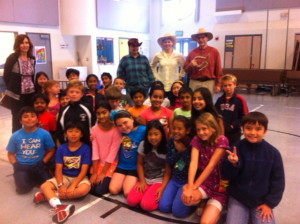
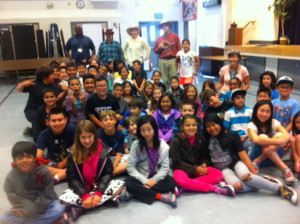
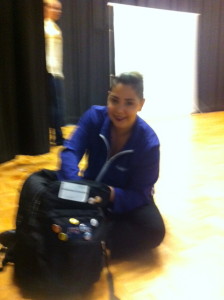
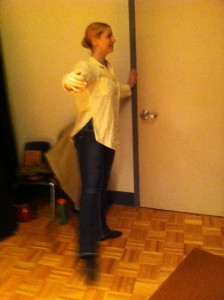 Top: two of the classes attending The Gold Rush! May 30, 2014. Bottom row, L to R: Audreyanne Covarrubias, Amity Johnson backstage preparing to perform.
Top: two of the classes attending The Gold Rush! May 30, 2014. Bottom row, L to R: Audreyanne Covarrubias, Amity Johnson backstage preparing to perform.
Lively’s Gold Rush comes to Fremont!
The Lively Foundation presented its rousing performance, The Gold Rush! at the Harvey Green School, Fremont, CA, April 4, 2014. Response was tremendous for this entertaining and painlessly educational show. The students had a lottery to see who would get to be in a picture with the performers. Here are the winning students, performers Audreyanne Covarrubias, Jonathan Clark, Amity Johnson, and teacher Melanie MacAdams. Ms MacAdams already told us she wants us back next year. The Gold Rush is part of the core curriculum for California students. The Lively Foundation has supported educators and students with our amazing program since 2000. 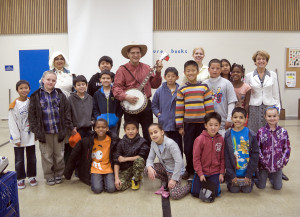
International Dance Festival@Silicon Valley: The Artist/Teachers!
Here they are: dance artists who will open your dancer heart and help you to reach the heights of your dancing! Leslie Arbogast, Leanne Rinelli, Leslie Friedman will lead the M2F (Monday to Friday!) classes in Dunham technique, Salsa, and Contemporary tech and composition. On The Full Day of Dance© they are joined by Sohini Ray, teaching Manipuri classical Indian Dance, Etta Walton teaching Etta’s Electric Lines, Audreyanne Delgado-Covarrubias teaching tap, Amity Johnson teaching Pilates mat. Give yourself a chance to dance! August 11-17. It’s here before you know it; register now to get your Early Bird Discounts. Apply now for scholarship aide. Scroll down a couple of entries to get links for the forms. Then: come on and DANCE!
Questions? email livelyfoundation@sbcglobal.net
International Dance Festival@Silicon Valley: Beauty & Fun in Mountain View
Live your dreams. DANCE. You can do it! Why come to Mountain View, California to dance? IDF@SV offers you the finest artists who want you dance your best. Teaching artists who want your artistry to shine. (SCROLL DOWN TO ENTRY BELOW THIS ONE FOR REGISTRATION FORMS.)And, Mountain View has it all, that’s why. Castro St. is the charming main street downtown. It is lined with bookstores, cafes, and restaurants. Not sure what to eat? You can choose from Chinese, Japanese, Thai, Mediterranean, Italian, fish, burgers, vegetarian, & lots more, all in one walkable area. Need to grab a quick salad between classes? That’s available, too, just a block away. That block is actually Pioneer Park. It has beautiful trees, grassy places and benches to sit on, an awesome Japanese garden of plants and rocks donated by Mountain View’s sister city. The Mountain View Masonic Center, home for the International Dance Festiva@Silicon Valley, is next to the park and the Mountain View Public Library, a great place to read and relax or use one of their computers. Worried you’ll miss big city life? Mountain View is the world headquarters of Google. Microsoft, Apple, and dozens and dozens of amazing companies right here. In the Starbucks one block from the Festival Headquarters, you’ll see computer wizards working on the newest biggest thing. See the Pacific Ocean? It’s just over the mountains or down the highway to Santa Cruz, Monterey, Carmel. Take a train, bus, or car to San Francisco–when you have time. You’ll be dancing your heart out every day & performing new works for a dance loving public on Sunday on a program with the acclaimed artists who were teaching you their work all five days before. Don’t miss this chance! Live your dreams. Dance. picture: Leslie Friedman, Artistic Director
picture: Leslie Friedman, Artistic Director